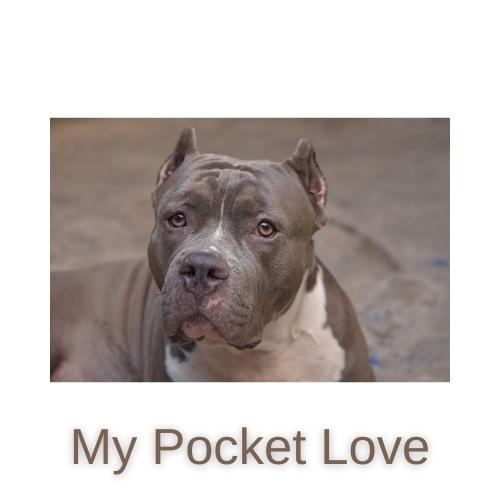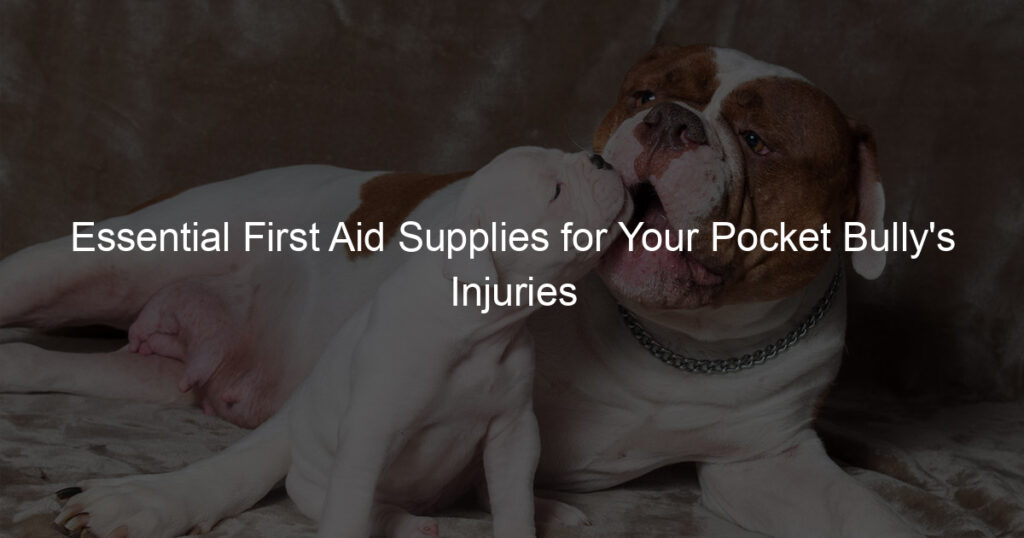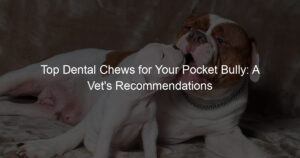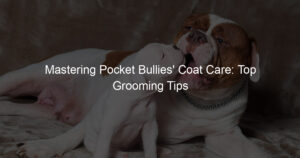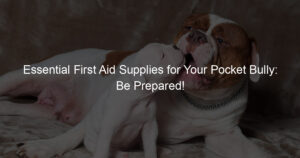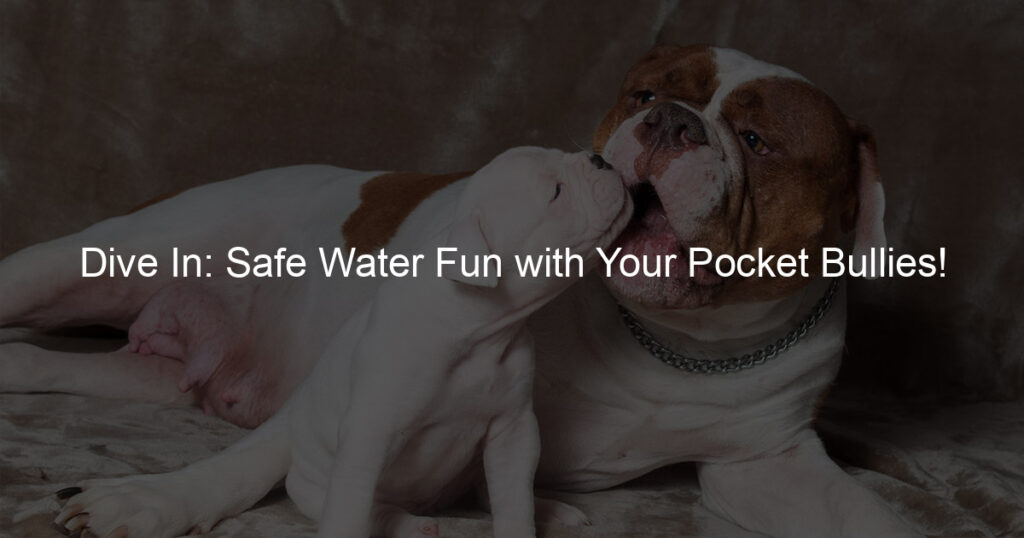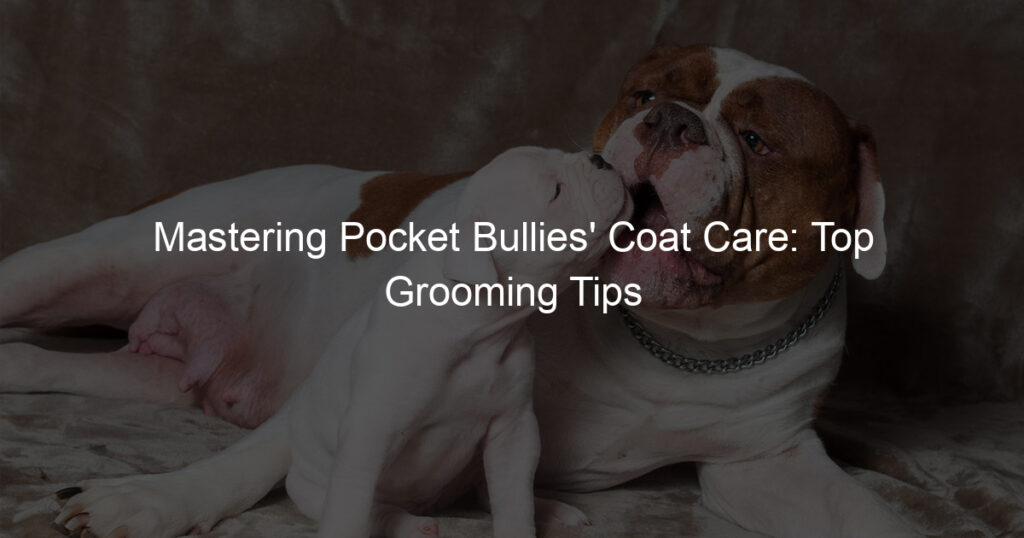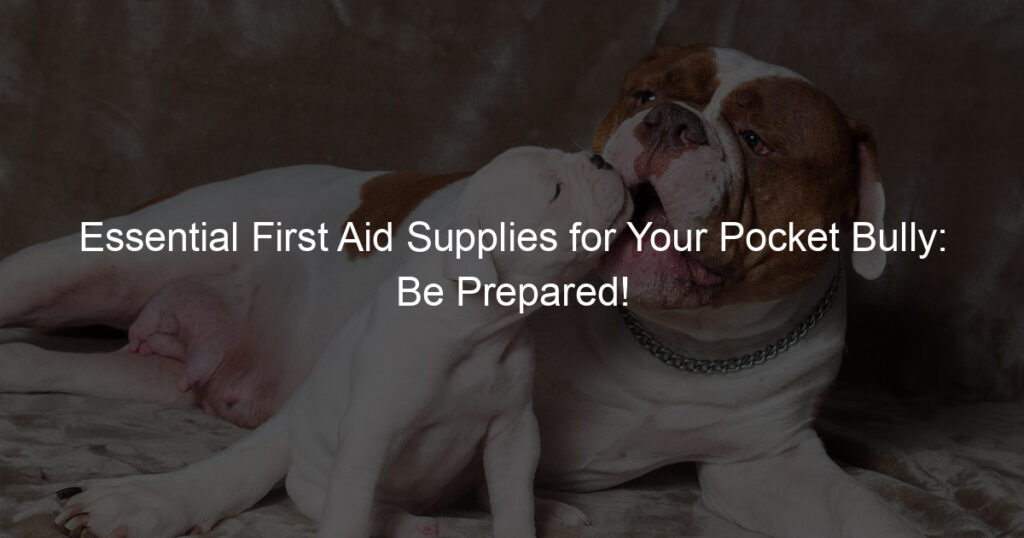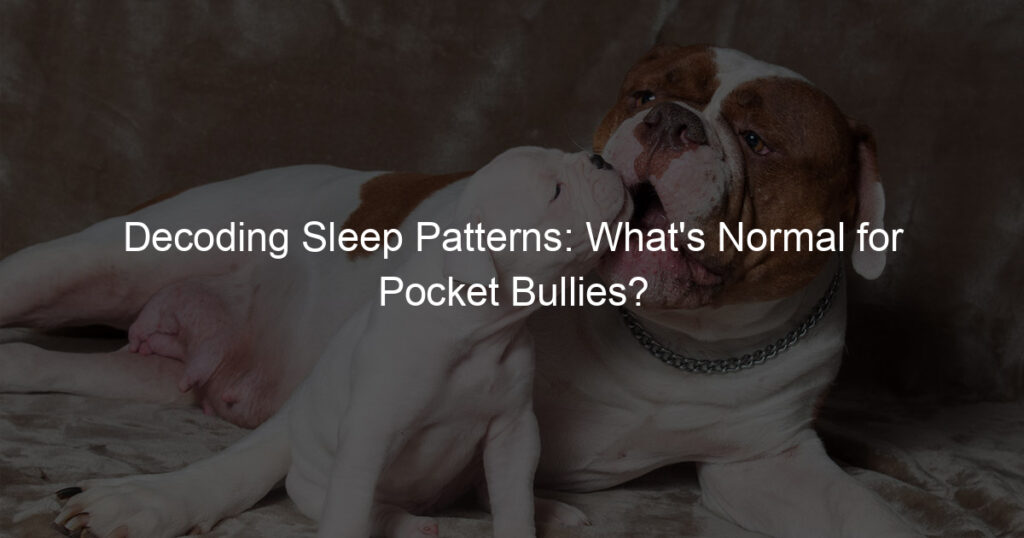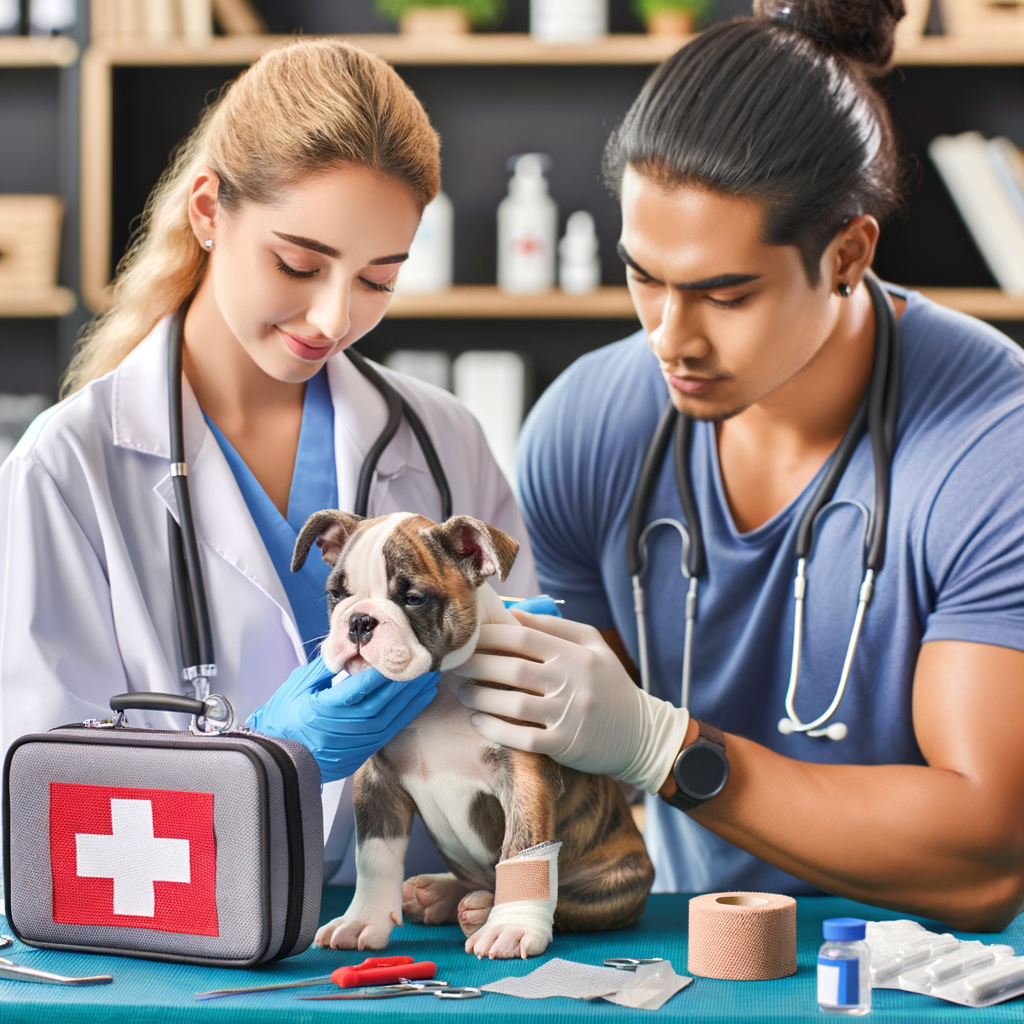
Introduction to Pocket Bullies First Aid
First aid is a critical aspect of caring for any pet, and Pocket Bullies are no exception. This breed, known for its muscular build and friendly nature, requires special attention when it comes to health and safety. In this section, we will explore the importance of first aid for Pocket Bullies and the basic principles of first aid for dogs.
- Understanding the importance of first aid for Pocket Bullies
- Basic principles of first aid for dogs
- Assessing the situation: Before you can help your dog, you need to understand what’s wrong. This might involve checking for visible injuries, monitoring breathing and heart rate, or noting any unusual behavior.
- Keeping calm: Dogs can sense stress and panic, which can make them more anxious in an already stressful situation. It’s important to stay calm and reassure your dog while you administer first aid.
- Seeking professional help: First aid is a temporary solution. It’s crucial to get your dog to a vet as soon as possible for professional medical attention.
First aid is not just about reacting to emergencies; it’s about being prepared for them. Pocket Bullies, like all dogs, can encounter various health issues, from minor cuts and scrapes to more serious conditions like heat stroke or choking. Knowing how to respond in these situations can make a significant difference in your pet’s health and well-being. For instance, a study by the American Veterinary Medical Association found that dogs who received first aid before reaching a veterinary hospital had a survival rate 2.5 times higher than those who didn’t.
First aid for dogs revolves around several key principles. These include:
By understanding the importance of first aid and the basic principles involved, you can ensure that you’re prepared to help your Pocket Bully in any situation. Remember, your knowledge and quick action could save your pet’s life.
Essential First Aid Supplies for Your Pocket Bullies
When it comes to the health and safety of your Pocket Bullies, being prepared is key. Having a well-stocked first aid kit can make all the difference in an emergency situation. Here, we will discuss the essential items you should have in your first aid kit for your Pocket Bullies.
First Aid Kit for Pocket Bullies
Let’s take a look at the most important items you should have in your first aid kit:
- Bandages and gauze: These are crucial for covering wounds and preventing infection. They can also be used to apply pressure to a bleeding wound and to protect it while it heals.
- Antiseptic wipes: These wipes are used to clean wounds and prevent bacteria from causing an infection. They are easy to use and can be a lifesaver in an emergency.
- Tweezers and scissors: Tweezers can be used to remove foreign objects from wounds, while scissors are essential for cutting bandages, gauze, and other materials.
- Hydrogen peroxide: This is used to clean wounds and kill bacteria. However, it should be used sparingly as it can also damage healthy tissue.
Remember, the first aid kit is just the first step in dealing with an injury. If your Pocket Bully is hurt, it’s important to get them to a vet as soon as possible. But having these supplies on hand can help you manage the situation until you can get professional help.
Additional Supplies for Dog Injuries
When it comes to caring for your Pocket Bullies, there are some additional supplies that you should always have on hand. These items can make a significant difference in the event of an injury. Let’s take a look at these essential items:
- Thermometer: A thermometer is a must-have in your dog first aid kit. It can help you monitor your dog’s temperature in case of illness or injury. Remember, a normal temperature for dogs is between 101 and 102.5 degrees Fahrenheit.
- Blanket: A blanket can serve multiple purposes. It can keep your dog warm in case of shock, and it can also be used to gently wrap and transport your dog if necessary.
- Muzzle: Even the friendliest dog might bite when in pain. A muzzle can protect you and others while you attend to your dog’s injuries. However, never use a muzzle if your dog is vomiting or has difficulty breathing.
- Eye dropper: An eye dropper can be used to administer medication or to flush out wounds. It’s a versatile tool that can be very useful in many situations.
Remember, these supplies are additional to the basic first aid kit items. They are not meant to replace veterinary care, but they can help you manage an emergency situation until you can get your Pocket Bullies to a vet.
Handling Injuries in Pocket Bullies
When it comes to our beloved pocket bullies, their health and well-being are our top priorities. Injuries, whether minor or major, can occur at any time. It’s crucial to know how to handle these situations to prevent further harm to your pet.
Managing Pocket Bullies Injuries
Managing injuries in pocket bullies involves understanding how to handle minor injuries and knowing when to seek professional help. Let’s delve into these two critical aspects:
- How to handle minor injuries
- When to seek professional help
Minor injuries such as small cuts, scrapes, or bruises can often be managed at home. First, clean the wound with warm water and mild soap to remove any dirt or debris. Then, apply an over-the-counter antibiotic ointment and cover it with a clean bandage. Monitor the injury closely for signs of infection, such as redness, swelling, or pus.
While minor injuries can be handled at home, more serious injuries require immediate professional attention. If your pocket bully has a deep cut, broken bone, difficulty breathing, or shows signs of severe pain, it’s time to seek help from a veterinarian. Remember, it’s always better to be safe than sorry when it comes to your pet’s health.
Handling injuries in pocket bullies can be a daunting task, but with the right knowledge and preparation, you can ensure your pet’s safety and well-being. Always remember to stay calm, act quickly, and when in doubt, seek professional help.
First Aid for Specific Injuries
When it comes to the health and safety of your Pocket Bullies, knowing how to administer first aid for specific injuries is crucial. Here, we will discuss first aid for cuts and scrapes, broken bones, choking, and poisoning.
-
First Aid for Cuts and Scrapes
Cuts and scrapes are common injuries for Pocket Bullies. It’s important to clean the wound immediately with warm water and mild soap. Apply a pet-friendly antiseptic and cover the wound with a clean bandage. Monitor the wound for signs of infection like redness, swelling, or pus.
-
First Aid for Broken Bones
Broken bones can be extremely painful and dangerous for your Pocket Bullies. If you suspect a broken bone, do not attempt to set it yourself. Instead, immobilize the affected area if possible and transport your pet to the vet immediately. Use a blanket or towel as a makeshift stretcher to avoid causing more harm.
-
First Aid for Choking
If your Pocket Bullies are choking, they may paw at their mouth, have difficulty breathing, or make choking sounds. Carefully open their mouth and see if you can remove the obstruction. If you can’t, or if they become unconscious, perform the Heimlich maneuver and rush them to the vet.
-
First Aid for Poisoning
Poisoning is a serious situation. If you suspect your Pocket Bullies have ingested something toxic, call your vet or a pet poison control center immediately. Do not induce vomiting unless instructed to do so. Keep the packaging of the suspected poison, as it can help identify the best treatment.
Remember, these first aid tips are meant to be temporary solutions until you can get your Pocket Bullies to a professional. Always consult with your vet if you have any concerns about your pet’s health.
Pocket Bullies Health Care
When it comes to your Pocket Bullies’ health, prevention is always better than cure. By taking a few simple steps, you can ensure that your furry friend stays healthy and happy. Let’s explore some preventive measures that can help.
Preventive Measures
Preventive measures are actions you can take to avoid health problems before they occur. Here are some key steps you can take to ensure your Pocket Bullies’ well-being:
- Regular Vet Check-ups: Regular visits to the vet are crucial for your Pocket Bullies’ health. These check-ups allow the vet to monitor your pet’s health and catch any potential issues early. For instance, vets can spot signs of dental disease, heart problems, or other health conditions that might not be visible to the untrained eye.
- Proper Diet and Exercise: Just like humans, Pocket Bullies need a balanced diet and regular exercise to stay healthy. A diet rich in high-quality proteins, fruits, vegetables, and whole grains can help maintain your pet’s weight, keep their coat shiny, and boost their immune system. Regular exercise, on the other hand, can help your Pocket Bullies stay fit and active, reducing the risk of obesity and related health problems.
- Regular Grooming: Regular grooming is not just about keeping your Pocket Bullies looking good, it’s also about their health. Brushing their coat helps remove dead hair, dirt, and dandruff. Regular baths can help prevent skin infections and parasites. Plus, grooming gives you a chance to check for any unusual signs such as lumps, rashes, or signs of infection.
Remember, your Pocket Bullies depend on you for their health and well-being. By taking these preventive measures, you can ensure that they live a long, healthy, and happy life.
Understanding Your Pocket Bullies Health
Just like humans, Pocket Bullies can also experience health issues. Understanding these health problems is the first step in ensuring your pet’s well-being. Let’s delve into the common health issues, signs of health problems, and ways to keep your Pocket Bullies healthy.
- Common health issues in Pocket Bullies
- Signs of health problems
- How to keep your Pocket Bullies healthy
Pocket Bullies are generally healthy dogs, but they can be prone to certain health conditions. These include hip dysplasia, a condition where the hip joint doesn’t fit together properly, and brachycephalic syndrome, a condition common in short-nosed breeds that can lead to breathing difficulties. Other health issues can include skin allergies, heart conditions, and obesity.
It’s important to be aware of the signs that your Pocket Bully may not be feeling well. These can include changes in behavior, such as becoming more quiet or lethargic, loss of appetite, excessive scratching or licking, difficulty breathing, or limping. If you notice any of these signs, it’s important to seek veterinary care as soon as possible.
Keeping your Pocket Bully healthy involves a combination of regular vet check-ups, a balanced diet, and regular exercise. It’s also important to keep them groomed and to monitor their weight. Regular play and mental stimulation can also contribute to their overall health and happiness.
Remember, your Pocket Bully depends on you for their health and well-being. By understanding their health issues and knowing how to spot signs of illness, you can ensure they live a long, happy, and healthy life.
Conclusion: First Aid for Pocket Bullies
In this article, we have covered the essential aspects of first aid for Pocket Bullies. It is important to remember that the health and safety of your pet is a priority. Let’s recap the key points we have discussed.
- Recap of essential first aid supplies:
- Importance of knowing how to handle injuries:
- Emphasis on preventive health care:
Having a well-stocked first aid kit is crucial. It should include items such as bandages, antiseptic wipes, a digital thermometer, a blanket, and tweezers. These supplies will help you handle minor injuries and stabilize your pet until you can reach a vet.
Understanding how to handle injuries is vital. For instance, if your Pocket Bully has a wound, you should clean it with an antiseptic wipe and bandage it. If your pet has a high temperature, it’s important to cool them down and get them to the vet as soon as possible. Remember, your actions can make a significant difference in your pet’s recovery.
Preventive health care is the best way to keep your Pocket Bully healthy. Regular vet check-ups, a balanced diet, and regular exercise can prevent many health issues. Also, keeping your pet’s living environment clean can help prevent infections and diseases.
In conclusion, being prepared and knowing how to handle emergencies can greatly improve the outcome for your Pocket Bully. Remember, your pet relies on you for their well-being, so it’s up to you to ensure they get the best care possible. Stay informed, stay prepared, and your Pocket Bully will thank you for it.
